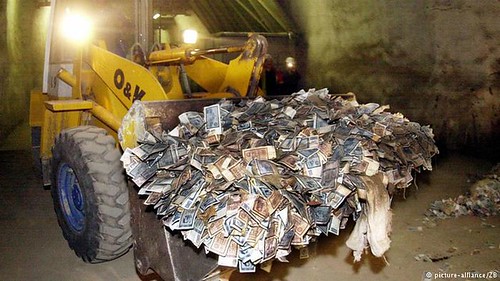
PREV ARTICLE
NEXT ARTICLE
FULL ISSUE
PREV FULL ISSUE
THE END OF EAST GERMANY'S CENTRAL BANKHoward Berlin forwarded this story of the demise of East Germany's central bank and the fate of its banknotes -Editor
 Printing money is not cheap, either is destroying it. Here deep underground workers are unearthing piles of East German marks to be incinerated. This huge project cost an estimated €500,000 This week marks the 28th anniversary of the monetary union between East and West Germany. What promised to be a healing cure-all for both sides killed the East German mark and is still a work in progress today. If the East German central bank is remembered for anything, it's usually only remembered for one thing — its sudden and utter demise. The Berlin Wall fell on November 9, 1989. A few months later on Sunday, July 1, 1990, the East German central bank handed over its monetary policy sovereignty to West Germany's Bundesbank — more than three months before the two countries actually became one. Suddenly the East German mark, called Mark der DDR, was out and the West German mark was officially in as the country's sole legal tender. Money in East German banks was automatically converted. But the nearly 17 million East Germans only had six days to convert their hard cash or lose it. But what happened to all that East German cash? According to KfW, in the runup to the monetary union, 620 million notes with a value of 17.8 billion marks were deposited for exchange. In total, 431 billion East German marks were exchanged for the West mark, 62 billion of that at a 1:1 exchange rate, the rest at the higher 2:1 ratio. Suddenly banks were inundated with worthless currency and had to find a solution. Coins weighing 450,000 tons and nominally worth 640 million marks were simply melted down right away for their metal — mostly aluminum. Paper money though had another life of its own. All of the notes, including the cash collected during the monetary union and the never-issued 200- and 500-mark notes, were gathered and hidden in underground tunnels near Halberstadt in rural Saxony-Anhalt. It was assumed that moisture mixed with the poor quality of the notes would lead to their decay, but that didn't happen. After break-ins and thefts, the KfW caretakers decided to speed up the process. In early 2002, all that remained of the 3,000 tons of the cash was dug up. Eventually 298 truckloads were sent to an incinerator, mixed with household trash and burned, bring an end to part of East German history. To read the complete article, see:  Wayne Homren, Editor The Numismatic Bibliomania Society is a non-profit organization promoting numismatic literature. See our web site at coinbooks.org. To submit items for publication in The E-Sylum, write to the Editor at this address: whomren@gmail.com To subscribe go to: https://my.binhost.com/lists/listinfo/esylum All Rights Reserved. NBS Home Page Contact the NBS webmaster 
|